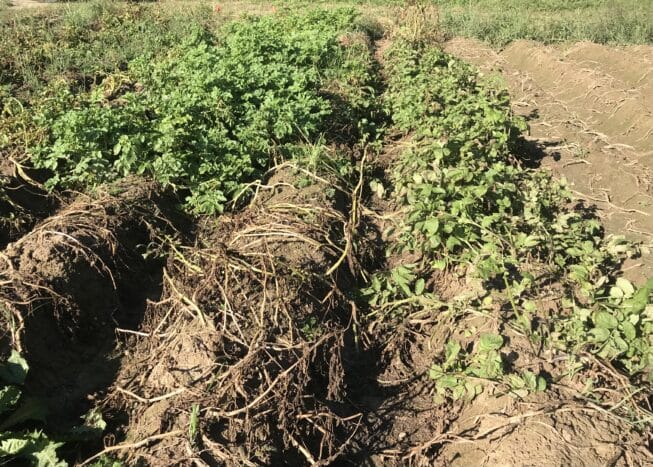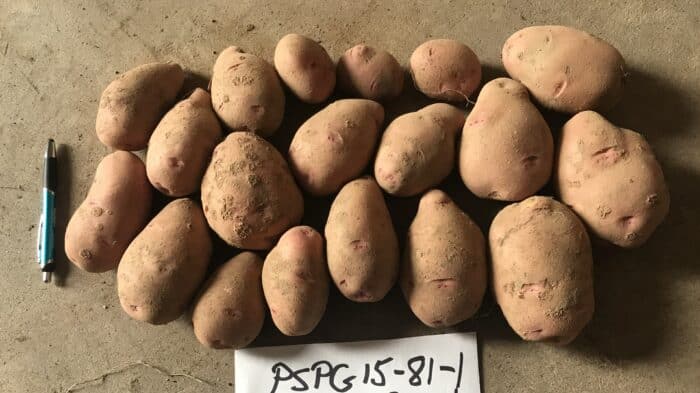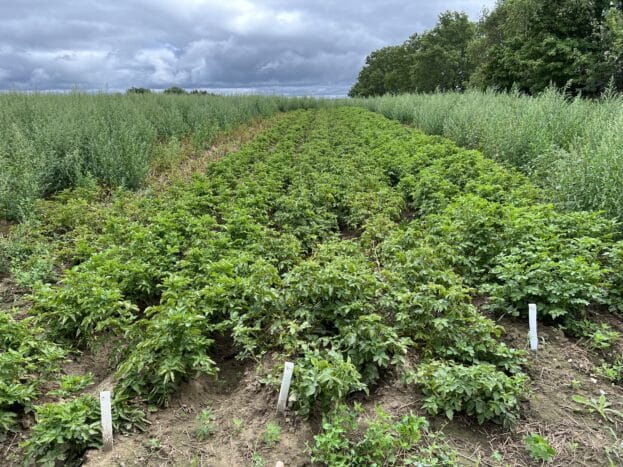While three Canadian potato varieties are showing promise to reduce disease incidence internationally, they may also help back home.
Peter VanderZaag is well respected in the Canadian potato industry, and that respect expands beyond borders. Over the years VanderZaag has worked in countries around the globe, spending the past 43 years breeding potato varieties for countries in Africa and Asia. Due to his previous success, he has continued to be asked for help breeding varieties resistant to various diseases and for particular markets.
“I’ve lived a half my life overseas, in Africa and Asia. I’ve worked in over 60 countries. So, you can imagine how many people I know. Many people have even requested or are requesting this from us or from me,” he explains in a phone interview.
Over the past few decades, he’s worked here in Canada with colleagues in the Canadian Private Potato Breeder’s Network (CPPBN), including Joyce and Robert Coffin, Andre Gagnon, Darin Gibson and Debbie Jones, to breed disease resistant varieties. And while those varieties are showing promise overseas there’s also interest growing for them back home.
“Late blight is a problem for us in organic produce. Well, it’s problem for conventional, but there’s ways to manage it. In organic production, it’s a bit trickier. So, if there would be something that we could gain with some late blight resistance, and still maintain good quality and good yields, that would be a win for us for sure,” Gord Penner, senior agronomist for Kroeker Farms, says in a phone interview.

Three varieties, PSPG 15-80-81, PSPG 15-90-1, and PSPG 15-80-9LB, are being tested internationally in countries in Africa, Asia, and back in Canada in Winkler, Man. at Kroeker Farms and at EarthFresh, Wider Sky Farms and Sunrise Potatoes in Ontario, this year. They’ll also be tested soon in South America. The varieties have resistance to late blight and just may help move potato production forward internationally and in Canada.
International Interest in Canadian Bred Spuds
VanderZaag’s contacts in the Philippines, Guinea and Kenya, were struggling with late blight taking out their potato crops. They were wanting late blight resistant variety options and asked him for help.
VanderZaag started by receiving the potato variety Cooperation 88 (SP328 in Canada) from China back to Canada to work with. The variety wasn’t adapted for Canadian conditions and would produce excess foliage, long stolons and many small tubers. VanderZaag, and the CPPBN group he was working with, decided to cross it with Shepody and Prospect, two french fry varieties. The hope was the offspring would have resistance to late blight, the cooking qualities of Cooperation 88 and the french fry qualities of Shepody and Prospect, while being adapted to long and short-day growing conditions.
From there they were able to select clones that ranged from early maturing to medium maturing in Canada. VanderZaag notes late maturing varieties will mature earlier the closer they are planted to the equator as the length of the day determines how long it’ll take a potato to grow. Numerous clones with the parent Cooperation 88 were selected having all been adapted to long day conditions.
The next consideration the group looked at for picking varieties was consumer preference. In Burma, they want white skinned varieties. While in Kenya there’s starting to be more western fast-food restaurants so buyers want varieties such as russet for fry making.
“This is really helping us in our work to make this a reality by providing what we think are the right materials to select from to have a local variety well adapted, resistant to late blight and can meet the demand of the buyer,” VanderZaag explains.
The varieties the group settled on are PSPG 15-80-81, PSPG 15-90-1, and PSPG 15-80-9LB. There are other varieties which are being tested in various countries, but the three main ones being trialled internationally and in Canada are these three.

PSPG 15-80-81 is an attractive long yellow high yielding variety that produces medium sized tubers and has french fry and table stock potential. PSPG 15-90-1 has long symmetrical tubers, is high yielding and is heat and drought tolerant. It has had good reviews as a table variety. PSPG 15-80-9LB produces red tubers and is medium yield. It has late maturity and has shown high resistance to late blight.
Andre Gagnon, a private potato breeder with Progest 2001, Quebec Parmentier, has worked with VanderZaag on breeding international varieties. Gagnon has connections in South American through Quebec Parmentier’s seed business, so he has helped line up trials in countries in the Caribbean and South America.
“There is some option to sell those new varieties and later on those seed to African countries or maybe Asian countries that they really need material with good adaptation and disease resistance,” Gagnon explains in a phone interview.
Possibilities for Potato Varieties Back Home
Kroeker Farms grows 1,300 acres of organic fresh potatoes around Winkler, Man. The fresh potato farm also grows its own seed potatoes on land in Saskatchewan and grows conventional potatoes, making for a grand total of 5,500 acres of potatoes planted annually.
Kroeker Farms first heard about the VanderZaag’s late blight resistant potato varieties during the winter of 2022. Penner received a call from Gibson at Gaia Consulting who had been working with VanderZaag on the late blight resistant varieties. Gibson knew Kroeker Farms struggled to control late blight on their organic acres and thought these varieties might just be able to help them out.
When Penner first heard about the possibility, he was told they were focusing on breeding russet processing varieties which wouldn’t work for Kroeker Farms. After hearing more details and finding out they had three red skinned varieties, Penner was more interested.
“They’re yellow flesh which I think that’s a market for the organic side,” Penner explains. “I know Peter’s continuing his breeding work to develop all kinds of different options. We do grow some red skin yellows already on the organic side and so this is not a big stretch for us for that reason.”

Due to the wet spring in Manitoba, the varieties were planted late on Kroeker Farms irrigated land this year. The varieties are late maturing, so there is concern if there’s enough growing days for them. Penner says they’re looking good though as of mid-August.
“We’ve had no late blight pressure at all. So, from that point of view, evaluating that side of things is not probably going to be an option this year,’ he explains.
While there won’t be the opportunity to test for late blight resistance this year, Penner is hoping the crop yields well so they can keep planting it and test late blight resistance in the future. He adds he has asked VanderZaag about the possibility of Colorado Potato Beetle resistant varieties.
“(VanderZaag) says they’ve got some lines that they’re working on? I don’t know what timeframe that would be to release. But it seems like they’re doing some really exciting work that would help the potato industry in Canada,” Penner says.
Header photo — A field of organic potatoes at Kroeker Farms in Winkler, Man. Photo: Megan Waldner
Related Articles
The Business of Private Potato Breeding in Canada
New Environmentally Friendly Control Method for Late Blight Discovered








